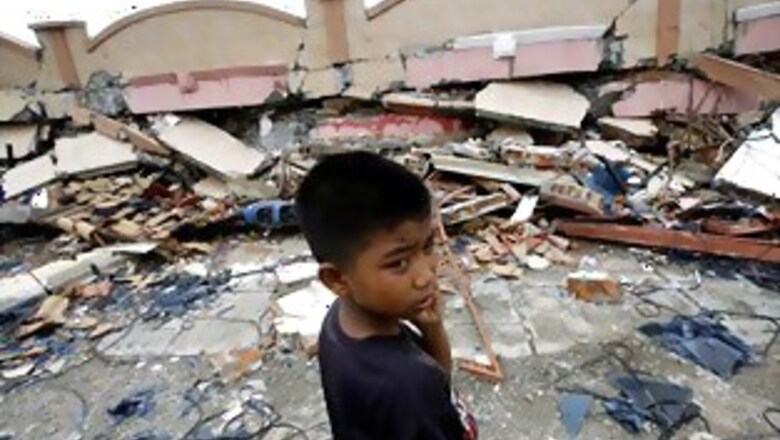
views
Padang, Indonesia: Rescue teams struggled on Thursday to reach scores of people trapped under debris and survivors pleaded for aid after a powerful quake hit the Indonesian city of Padang, possibly killing thousands.
The 7.6 magnitude quake struck the bustling port city of 900,000 people on Wednesday, toppling hundreds of buildings. Telephone connections were patchy, making it hard for officials to work out the extent of destruction and loss of life.
"I have been through quakes here before and this was the worst. There is blood everywhere, people with their limbs cut off. We saw buildings collapsed, people dying," said American Greg Hunt, 38, who was at Padang airport.
A Reuters reporter in the city said rescuers were pulling people from buildings, but there was little sign of much aid being distributed yet. Fuel was also in short supply and there was a report of looting, while some shops had run out of food.
Health Minister Siti Fadillah Supari told reporters at an airport in Jakarta before leaving for Padang that the number of dead could be numbered in the thousands, given the widespread damage. A worker compiling disaster data at the social ministry put the number killed of confirmed deaths at 529.
President Susilo Bambang Yudhoyono, who arrived back from the G20 meeting on Thursday, told reporters the country could coordinate the relief efforts but welcomed help from abroad.

Australia, South Korea and Japan were among nations offering aid or help.
Two Indonesian Hercules transport planes carrying medical aid, as well as 20,000 tents and 10,000 blankets, also flew to Padang on Thursday, the state Antara news agency reported.
A 6.6 magnitude quake hit another part of Sumatra island on Thursday, causing fresh panic but no reported deaths. The second quake's epicentre was about 225 km (140 miles) southeast of Padang, the US Geological Survey said.
Elshinta radio reported that 12 people were hurt in the town of Jambi and 60 houses damaged.
Hospital damaged
A two-storey clinic at Padang's main hospital collapsed but was empty at the time after closing a few hours before the quake.
Patients from adjacent wards were evacuated to nearby tents, while a makeshift morgue was also setup in the open air with lines of corpses placed in yellow body bags.
PAGE_BREAK
One distraught man collapsed after identifying his daughter as one of the victims.
Operations were being conducted in nearby white tents.
"We have done hundreds of operations since the earthquake," said Dr Nofli Ichlas. "Some broken bones, some with limbs completely cut off. Fractured skulls, abdominal trauma too--when something has stabbed into the patients body."
Heavy rain initially hampered rescue efforts and officials said power had been cut in Padang, which lies on a coastal plain and is surrounded by steep mountains that stretch far inland.
Damage to roads had affected transport of rubber in West Sumatra, the fifth-largest producing province for rubber in Indonesia.
Sumatra also has some of Indonesia's largest oil fields as well as a liquefied natural gas terminal, but there were no reports of damage at those facilities.
People crowd airport to flee city
Sumatra is one of the world's most seismically active places. A 9.15 magnitude quake, its epicentre 600 km northwest of Padang, caused the 2004 tsunami that killed 230,000 people in Indonesia and other Asian nations.
Australian businesswoman Jane Liddon told Australian radio from Padang that the city centre was devastated.
"The big buildings are down. The concrete buildings are all down, the hospitals, the main markets, down and burned."
The Ambacang Hotel had also collapsed and an official said people remained trapped in the Dutch colonial-era building.
On the road into the Padang area, Nasaruddin, 45, had constructed a make-shift shelter from poles and a tarpaulin to try and shelter his family after his house had collapsed.
"We just ask that people know that we need donations very badly. Look at my family," said the father-of-four.
Padang's airport was operating, although many people were camping out on prayer mats as they tried to flee the city, while soldiers and aid groups such as the Red Crescent arrived.
Patrick Werner, 28, a German tourist at the airport, was on a beach when the quake struck. Some overseas visitors use Padang as an entry point to visit nearby beaches and mountains.
"We saw some cracks emerge in the soil and water come out of the ground like it was Universal Studios," he said.
Officials said more heavy equipment such as bulldozers, excavators and concrete cutters were badly needed.



















Comments
0 comment